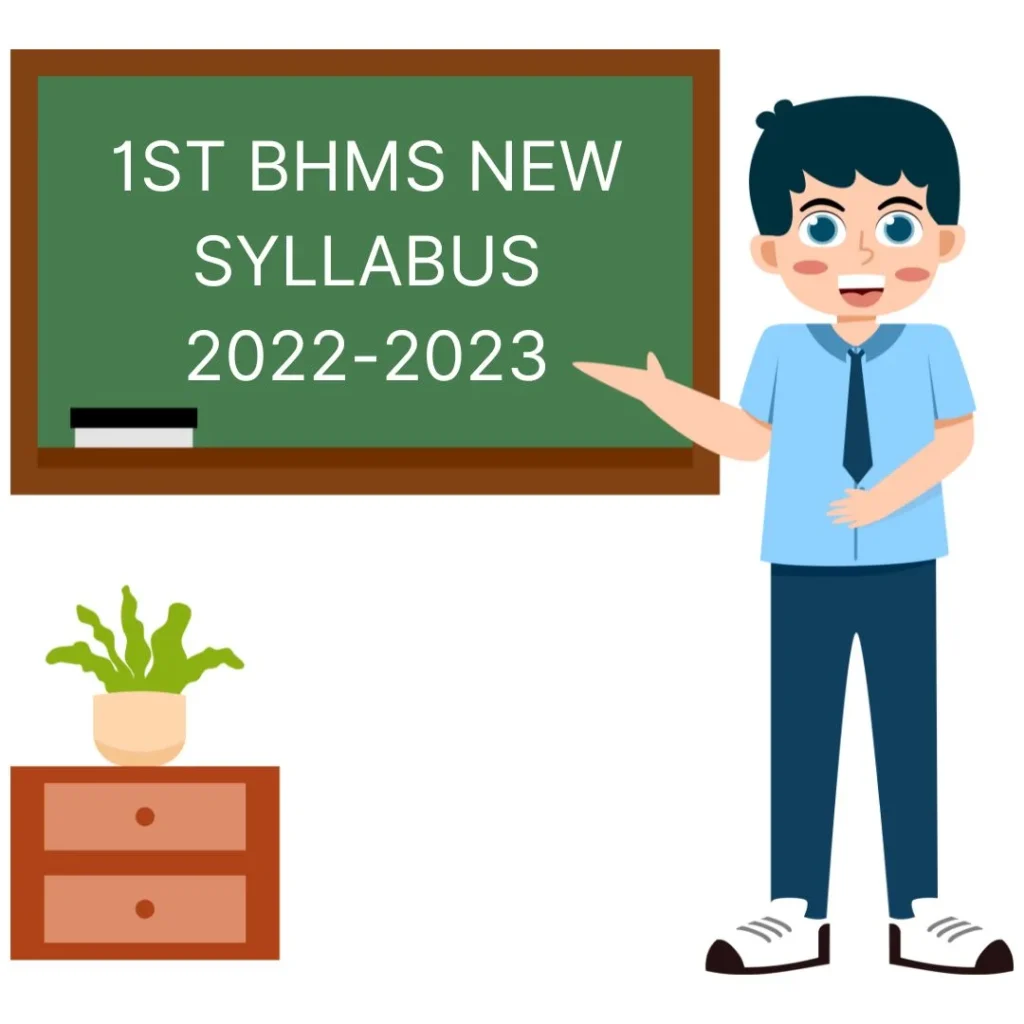Hey there, future homeopaths! 🎓 Starting your 1st BHMS (Bachelor of Homeopathic Medicine and Surgery) can feel overwhelming, but don’t worry—I’ve got you covered!
This post breaks down the new syllabus (2022-2023 onwards) in the simplest way possible, so you can focus on learning without the stress.
Whether you’re just starting or need a quick refresher, this guide will help you navigate your first year like a pro.
Table of Contents
ToggleWhat’s in the 1st BHMS Syllabus?
The 1st BHMS course includes 7 subjects, but you’ll only be tested on 5 of them. Here’s the list:
- Anatomy, Histology, and Embryology
- Human Physiology and Biochemistry
- Homoeopathic Pharmacy
- Homoeopathic Materia Medica
- Organon of Medicine and Philosophy
- Homoeopathic Repertory and Case Taking (No Exam)
- Yoga (No Exam)

Exam Structure
- Exam Subjects: Anatomy, Physiology, Pharmacy, Materia Medica, and Organon of Medicine.
- Non-Exam Subjects: Repertory, Case Taking, and Yoga (focus on practical learning).
1ST YEAR BHMS EXAM PATTERN (2022-2023) – COMPLETE GUIDE WITH SUBJECT-WISE MARKS & STUDY TIPS
Let’s Break It Down Subject by Subject
1. Anatomy, Histology, and Embryology
What You’ll Learn:
- The structure and function of the human body.
- How to identify bones, muscles, nerves, and organs.
- The basics of how babies develop in the womb (embryology).
Key Topics:
- General Anatomy: Cells, tissues, bones, joints, and muscles.
- Embryology: Development of organs like the heart, brain, and lungs.
- Histology: Studying tissues under a microscope.
- Regional Anatomy: Upper and lower limbs, head and neck, thorax, abdomen, and brain.
Practical Work:
- Dissecting cadavers (sounds scary, but it’s super interesting!).
- Identifying tissues and organs under a microscope.
- Keeping a record of your dissections and observations.
1ST BHMS NEW ANATOMY SYLLABUS: A DETAILED GUIDE FOR STUDENTS (2022-2023 ONWARDS)
1ST BHMS ANATOMY EXAM GUIDE: IMPORTANT QUESTIONS FOR PAPER 1 & PAPER 2 (2022-2023)
2. Human Physiology and Biochemistry
What You’ll Learn:
- How the body works—from cells to systems like the heart, lungs, and brain.
- The chemistry behind life—carbohydrates, proteins, fats, and more.
Key Topics:
- General Physiology: How cells function and maintain balance (homeostasis).
- Systems: How the heart pumps blood, how we breathe, and how the brain controls everything.
- Biochemistry: The role of vitamins, minerals, and enzymes in the body.
Practical Work:
- Blood tests (like checking hemoglobin levels).
- Urine analysis and liver/kidney function tests.
- Learning to measure blood pressure and interpret ECGs.
3. Homoeopathic Pharmacy
What You’ll Learn:
- How homoeopathic medicines are made—from raw materials to potentized remedies.
- The science behind drug dynamization and potentization.
Key Topics:
- Drug Sources: Plants, animals, minerals, and even nosodes (made from disease products).
- Preparation: Making mother tinctures, triturations, and liquid potencies.
- Dispensing: Preparing medicines in different forms like globules, tablets, and ointments.
Practical Work:
- Preparing mother tinctures and potencies.
- Testing the purity of water, alcohol, and sugar of milk.
- Visiting a GMP-compliant homoeopathic manufacturing unit.
- Creating a herbarium (a collection of plant samples used in homoeopathy).
1ST BHMS HOMOEOPATHIC PHARMACY THEORY SYLLABUS: A COMPLETE GUIDE FOR STUDENTS (2022-2023)
LATEST HOMOEOPATHIC PHARMACY QUESTION BANK FOR BHMS STUDENTS (2022-2023 SYLLABUS)
4. Homoeopathic Materia Medica
What You’ll Learn:
- The symptom profiles of key homoeopathic remedies.
- How to study remedies individually and compare them.
Key Topics:
- Introduction: What Materia Medica is and why it’s important.
- Remedies: Learning about 50+ remedies like Aconite, Belladonna, and Nux Vomica.
- Biochemic Tissue Salts: Understanding 12 tissue salts like Calc Phos and Nat Mur.
Practical Work:
- Collecting and studying plant samples for your herbarium.
- Analyzing cases and matching symptoms to remedies.
1ST BHMS HOMOEOPATHIC MATERIA MEDICA QUESTION BANK: SYLLABUS, REMEDIES, AND EXAM PREP
1ST BHMS HOMOEOPATHIC MATERIA MEDICA SYLLABUS: A COMPLETE GUIDE FOR STUDENTS (2022-2023)
5. Organon of Medicine and Philosophy
What You’ll Learn:
- The core principles of homoeopathy.
- Hahnemann’s teachings and how to apply them in practice.
Key Topics:
- Introduction: History of homoeopathy and Hahnemann’s contributions.
- Aphorisms: Studying the first 28 sections of the Organon (e.g., Law of Similia).
- Philosophy: Concepts of health, disease, and cure.
Practical Work:
- Practicing case-taking skills.
- Observing and analyzing cases in OPD/IPD.
6. Homoeopathic Repertory and Case Taking
What You’ll Learn:
- How to use repertories (like Kent’s) to find the right remedy.
- The art of taking a patient’s case effectively.
Key Topics:
- Introduction: What a repertory is and how it’s structured.
- Kent’s Repertory: Learning about chapters and rubrics.
- Case Taking: Techniques for gathering patient information.
Practical Work:
- Practicing repertorization (matching symptoms to remedies).
- Analyzing and evaluating cases.
1ST BHMS HOMOEOPATHIC REPERTORY AND CASE TAKING: A COMPLETE GUIDE FOR STUDENTS (2022-2023)
7. Yoga for Health Promotion
What You’ll Learn:
- The basics of yoga and its benefits for health.
- Simple asanas, pranayama, and meditation techniques.
Key Topics:
- Introduction: History and philosophy of yoga.
- Practices: Sun Salutation, relaxation techniques, and meditation.
- Correlation: How yoga complements homoeopathy.
Practical Work:
- Daily yoga practice sessions.
- Learning and performing basic asanas and breathing exercises.
1ST BHMS YOGA SYLLABUS: A COMPLETE GUIDE FOR STUDENTS (2022-2023)
Tips to succeed Your 1st BHMS
Here’s how to make the most of your first year:
- Understand, Don’t Memorize: Focus on concepts rather than rote learning.
- Get Hands-On: Actively participate in dissections, lab work, and clinical postings.
- Stay Organized: Keep track of your practical records and notes.
- Ask Questions: Don’t hesitate to clarify doubts with your professors.
- Balance Theory and Practice: Spend equal time on both to build a strong foundation.
